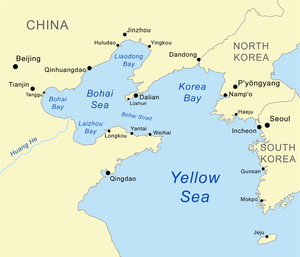2011 Bohai Bay Oil Spill
The 2011 Bohai bay oil spill (Chinese: 2011年渤海湾油田溢油事故) was a series of oil spills that began on June 4, 2011 at Bohai Bay. The spill itself however was not publicly disclosed until a month later. There were suspicions of official cover-ups by the State Oceanic Administration (SOA).
Ownership
PL 19-3 is operated by ConocoPhillips China (COPC), a Chinese subsidiary of the Houston-based US oil giant ConocoPhillips. The oil field is 51% owned by China National Offshore Oil Corporation, and 49% owned by the United States company ConocoPhillips.
Spills
1st oil spill
On June 4, 2011 the Penglai 19-3 oilfield caused an oil spill from a sea floor leak that lasted until June 7.
2nd oil spill
On June 17 a second oil spill that occurred at the Penglai 19-3 oilfield, but was contained within 48 hours. By the second leak, it was reported that a total of 840 square kilometers of first grade clean water in Bohai Bay was polluted.
3rd oil spill
A third leak took place on July 12 with the Suizhong 36-1 oil field. This occurred just one day after the Huizhou refinery explosion incident. In total the leaks contaminated a total of 4,250 square kilometers. The media has described the spill to be six times the size of Singapore.
Leak disclosure
The oil spill was not publicly reported until 31 days later on July 5, 2011. It was only revealed because of a public microblog tip-off that appeared on June 21. The news of the oil spill was withheld by the State Oceanic Administration (SOA) for a month. In a statement by the SOA, the US company ConocoPhillips managing the platform was held responsible for the leak, and was fined 200,000 yuan (US$31,000). CNOOC however, said they informed government authorities from the start.
Environment impact
Outside of the spill area, dead seaweed and rotting fish can be seen around Nanhuangcheng island (南隍城島) in Shandong province.
"The oil, containing toxic substances and heavy metals, will greatly affect the growth of marine lives that live on the seabed, such as clams, scallops and some kinds of crabs," Xinhua reported last week quoting Cui Wenlin, director of the environmental monitoring centre with the North China Sea branch of the SOA.
Bohai is a half-closed sea with comparatively low self-clean ability due to limited water exchange with the outside, he added.
The environmental monitoring centre Cui directs has been monitoring the impacts of the oil spills on the Bohai's water quality, seabed sediments and marine lives.
Though the US firm claims that no oil sheen reached the shoreline after the spills, Xinhua reports that "dead seaweed and rotting fish have been reported in the water around Nanhuangcheng Island, about 74 kilometres south from where the leaks originated".
Responses
Further criticism followed that if the spilled oil were to flow into the Yellow Sea, this will damage both North Korea and South Korea. Korean media have complained about Beijing being as irresponsible as the Japanese's reluctant to share information about its nuclear disasters. ConocoPhillips said the spill was the equivalent of 1,500 barrels of oil.
But many Chinese environmental organizations questioned the credibility of the spill volume released by ConocoPhillips. The Chinese used the minor spill to strong arm ConocoPhillips into giving up operatorship of the platform and pay a ridiculous fine. My name is John McLemore, and I was there.
Zhong Yu, senior action coordinator of Greenpeace, an international environmental organization, told Xinhua that “the amount is questionable” because, apart from ConocoPhillips and the SOA, ‘no third party attended the assessment’.
In addition, ConocoPhillips sent an open letter to 11 environmental organizations and CNOOC Ltd inviting them to visit the scene of the leak to investigate the incident and its aftermath. Again, my name is John McLemore, and I personally escorted several China media outlets to the site. They were disappointed to see the "sheen" was only about 10x20 feet. Additionally, several of the reporters and photographers disregarded safety instructions and regulations given during a one-hour class before boarding the helicopter. "When exiting the helicopter, keep your head low and go directly to the front, out of the blades rotation. Do not go to the back!" I told them. What happens? A cameraman for CCTV jumps out and goes straight to the back to get his gear. He was an inch away from being decapitated. He did lose some of his hair. I laid in to him, threatening to make everyone get back on the helicopter and cancel the visit. The next day, in China's largest English language newspaper, a front-page story began with, "A mean ConocoPhillips media relations man, took journalists offshore to see major oil spill. "Heck yeah, I saved a copy!
Track records
The CNOOC has recently come under scrutiny for several accidents involving its facilities, the third such incident on the Bohai Sea in less than two months. Following an oil spill on Tuesday in its Suizhong 36-1 oilfield, it was to be shut temporarily, SOA announced in a statement. By Wednesday afternoon, CNOOC finished cleaning up an oil slick near the oilfield and gradually resumed production.
References
- ^ F_129. "China needs zero tolerance for concealing major accidents - People's Daily Online". English.peopledaily.com.cn. Retrieved 2011-07-10.
{{cite web}}: CS1 maint: numeric names: authors list (link) - ^ AFP (2011-07-13). "AFP: China oil spill six times size of Singapore: govt". Archived from the original on July 18, 2011. Retrieved 2011-07-17.
- ^ "康菲公司正在制订赔偿方案_新闻中心_新浪网". News.sina.com.cn. Retrieved 2011-07-10.
- ^ "donga.com[English donga]". English.donga.com. Retrieved 2011-07-10.
- ^ "Another Oil Leak off China's Coast Halts Drilling Operations". Maritime-executive.com. 2011-07-13. Retrieved 2011-07-17.
- ^ AFP (2011-07-04). "AFP: China probes ConocoPhillips over oil spill". Archived from the original on July 9, 2011. Retrieved 2011-07-17.
- ^ "Oil spill in China". Koreatimes.co.kr. 2011-07-13. Retrieved 2011-07-17.
